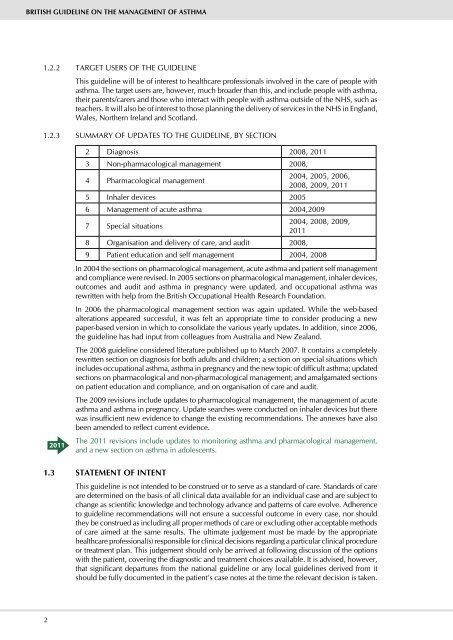sign101
sign101
sign101
You also want an ePaper? Increase the reach of your titles
YUMPU automatically turns print PDFs into web optimized ePapers that Google loves.
British Guideline on the MAnAGeMent of AsthMA<br />
1.2.2 TARGET USERS OF THE GUIDELINE<br />
2<br />
This guideline will be of interest to healthcare professionals involved in the care of people with<br />
asthma. The target users are, however, much broader than this, and include people with asthma,<br />
their parents/carers and those who interact with people with asthma outside of the NHS, such as<br />
teachers. It will also be of interest to those planning the delivery of services in the NHS in England,<br />
Wales, Northern Ireland and Scotland.<br />
1.2.3 SUMMARy OF UPDATES TO THE GUIDELINE, By SECTION<br />
2 Diagnosis 2008, 2011<br />
3 Non-pharmacological management 2008,<br />
4 Pharmacological management<br />
2004, 2005, 2006,<br />
2008, 2009, 2011<br />
5 Inhaler devices 2005<br />
6 Management of acute asthma 2004,2009<br />
7 Special situations<br />
2004, 2008, 2009,<br />
2011<br />
8 Organisation and delivery of care, and audit 2008,<br />
9 Patient education and self management 2004, 2008<br />
In 2004 the sections on pharmacological management, acute asthma and patient self management<br />
and compliance were revised. In 2005 sections on pharmacological management, inhaler devices,<br />
outcomes and audit and asthma in pregnancy were updated, and occupational asthma was<br />
rewritten with help from the British Occupational Health Research Foundation.<br />
In 2006 the pharmacological management section was again updated. While the web-based<br />
alterations appeared successful, it was felt an appropriate time to consider producing a new<br />
paper-based version in which to consolidate the various yearly updates. In addition, since 2006,<br />
the guideline has had input from colleagues from Australia and New Zealand.<br />
The 2008 guideline considered literature published up to March 2007. It contains a completely<br />
rewritten section on diagnosis for both adults and children; a section on special situations which<br />
includes occupational asthma, asthma in pregnancy and the new topic of difficult asthma; updated<br />
sections on pharmacological and non-pharmacological management; and amalgamated sections<br />
on patient education and compliance, and on organisation of care and audit.<br />
The 2009 revisions include updates to pharmacological management, the management of acute<br />
asthma and asthma in pregnancy. Update searches were conducted on inhaler devices but there<br />
was insufficient new evidence to change the existing recommendations. The annexes have also<br />
been amended to reflect current evidence.<br />
The 2011 revisions include updates to monitoring asthma and pharmacological management,<br />
and a new section on asthma in adolescents.<br />
1.3 stAteMent of intent<br />
This guideline is not intended to be construed or to serve as a standard of care. Standards of care<br />
are determined on the basis of all clinical data available for an individual case and are subject to<br />
change as scientific knowledge and technology advance and patterns of care evolve. Adherence<br />
to guideline recommendations will not ensure a successful outcome in every case, nor should<br />
they be construed as including all proper methods of care or excluding other acceptable methods<br />
of care aimed at the same results. The ultimate judgement must be made by the appropriate<br />
healthcare professional(s) responsible for clinical decisions regarding a particular clinical procedure<br />
or treatment plan. This judgement should only be arrived at following discussion of the options<br />
with the patient, covering the diagnostic and treatment choices available. It is advised, however,<br />
that significant departures from the national guideline or any local guidelines derived from it<br />
should be fully documented in the patient’s case notes at the time the relevant decision is taken.


